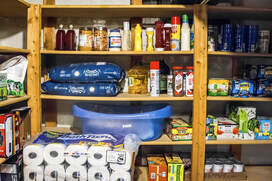|
This is the first in a series of blogs on recipes that you can easily prepare in a disaster or emergency without power. Scroll down to the bottom of this blog for links to all of the blogs in this series.  If you’re like me, you have dozens of gallons of water and food stored in a number of places. You could probably last more than a week without power, but you might not have thought through what that would be like. Is your stash of emergency food balanced in terms of nutrition, energy needs, and palatability? What factors should you consider to minimize any loss of your precious supplies? How might you supplement and extend your shelf-stable goods, once you’ve used up the fresh food from your fridge? Find out, as we discuss these day-to-day considerations in this blog series, Eating without Electricity. We start with Day 1, the power has gone out, and it may be out for days. What supplies do you use up first?
Day 1: Recipe/Prep-cipe: Emergency Salad When the electricity goes out, use up your perishables into a fresh salad.
*Don’t you hate when recipes say "to taste"? I mean, why am I reading your recipe if you’re going to tell me that my guess is as good as yours? Good thing this is a prep-cipe, or I’d be a hypocrite.) Blog Series LinksCheck out all of the blogs in the Recipes after a Disaster series: AuthorLincoln Thomas, Newsletter Editor, Neighbors Ready!
0 Comments
Leave a Reply. |
AuthorWrite something about yourself. No need to be fancy, just an overview. Archives
July 2024
Categories |
